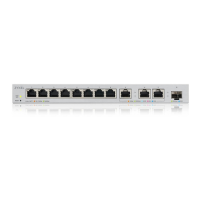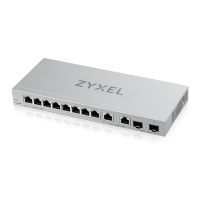Chapter 13 Spanning Tree Protocol
XS1930 Series User’s Guide
147
13.6.1 Multiple Spanning Tree Protocol Port Configuration
Click Advanced Application > Spanning Tree Protocol > MSTP > Port in the navigation panel to display
the status screen as shown next. See Multiple STP on page 139 for more information on MSTP.
Figure 107 Advanced Application > Spanning Tree Protocol > MSTP > Port
Priority Configure the priority for each port here.
Priority decides which port should be disabled when more than one port forms a loop in a
switch. Ports with a higher priority numeric value are disabled first. The allowed range is
between 0 and 255 and the default value is 128.
Path Cost Path cost is the cost of transmitting a frame on to a LAN through that port. It is recommended
to assign this value according to the speed of the bridge. The slower the media, the higher the
cost - see Table 60 on page 138 for more information.
Add Click Add to save this MST instance to the Switch’s run-time memory. The Switch loses this
change if it is turned off or loses power, so use the Save link on the top navigation panel to
save your changes to the non-volatile memory when you are done configuring.
Cancel Click Cancel to begin configuring this screen afresh.
Instance This field displays the ID of an MST instance. Click this number to modify its settings.
VLAN This field displays the VID (or VID ranges) to which the MST instance is mapped.
Active Port This field display the ports configured to participate in the MST instance.
Select an entry’s check box to select a specific entry.
Delete Check the rule(s) that you want to remove and then click the Delete button.
Cancel Click Cancel to clear the selected checkbox(es).
Table 65 Advanced Application > Spanning Tree Protocol > MSTP (continued)
LABEL DESCRIPTION

